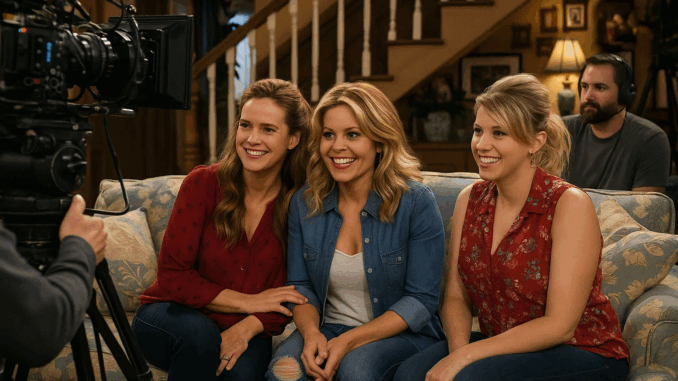
The Magic of a 90s Classic
When Full House first aired in 1987, few expected a wholesome family sitcom to become a global comfort brand. Yet the Tanner family—Danny, Uncle Jesse, Joey, D.J., Stephanie, and Michelle—became cultural icons. Decades later, audiences still hum “Everywhere You Look,” proving that some shows never fade; they simply evolve.
A Show Built on Heart and Humor
Unlike edgy sitcoms of its time, Full House stood out for its warmth. Each episode ended with a hug, a life lesson, and a moral that stuck. The writing balanced humor with genuine emotion, making it a safe space for families. That mix of sincerity and simplicity turned it into a timeless comfort watch.
The Nostalgia Boom and the Birth of Fuller House
When Netflix announced Fuller House in 2016, fans erupted online. It wasn’t just a reboot; it was a reunion of childhood memories. The show picked up decades later, with D.J. Tanner now a widowed mom raising her kids—with help from sister Stephanie and best friend Kimmy Gibbler. It mirrored the same dynamic that made the original magic.
Why Fuller House Worked
Critics might have been mixed, but audiences didn’t care. They wanted comfort, laughter, and nostalgia—and Fuller House delivered all three. It became one of Netflix’s most-watched comedies during its run, fueled by multi-generational viewership. The formula was simple: keep the heart, update the humor.
The Power of Familiar Faces
Seeing Candace Cameron Bure, Jodie Sweetin, and Andrea Barber reprise their roles felt like a warm reunion. Even guest appearances from John Stamos, Bob Saget, and Dave Coulier sparked emotional moments. Each cameo reminded fans that while the characters grew older, the love behind them never changed.
Nostalgia as an Industry Trend
The success of Fuller House opened the door for other reboots—Saved by the Bell, The Fresh Prince of Bel-Air, and Roseanne. But Full House stood apart because it wasn’t built on irony; it celebrated kindness in an age of cynicism. That authenticity became its secret weapon.
The Legacy of Bob Saget
The passing of Bob Saget in 2022 brought the Full House community together like never before. Tributes poured in from castmates and fans worldwide. Saget’s portrayal of Danny Tanner—the loving, meticulous dad—reminded viewers of the show’s emotional core. His memory keeps the spirit of Full House alive.
Why the Tanner Family Still Resonates
In a media world obsessed with shock value, Full House feels refreshingly sincere. Its lessons about family, forgiveness, and growth continue to resonate. Whether you grew up watching reruns or discovered it on streaming, the Tanners represent a version of home everyone wishes they had.
Could Full House Return Again?
Rumors of another revival occasionally surface. Cast members have expressed interest in future specials, and fans continue to push for a reunion episode or movie. With modern technology and audience nostalgia stronger than ever, a future return doesn’t feel impossible.
How Streaming Keeps Classics Alive
Platforms like Netflix and Max have turned comfort TV into a digital phenomenon. Full House thrives on these services, finding new generations of fans who binge the show like it’s brand new. The algorithm may have replaced primetime slots, but the love for classic sitcoms hasn’t changed.
The Timeless Appeal of Found Families
At its core, Full House isn’t just about biological bonds—it’s about chosen family. Jesse and Joey stepping in as father figures wasn’t just funny; it redefined what “family” could mean. That message feels even more relevant in today’s diverse households.
Lessons Modern Sitcoms Could Learn
While today’s comedies chase viral moments, Full House focused on emotional connection. It wasn’t afraid of being corny because it believed in hope. That kind of sincerity could actually stand out again in an era of sarcasm and dark humor.
Social Media and the New Wave of Nostalgia
TikTok and Instagram are filled with Full House clips, edits, and tributes. Younger audiences discover the show through short nostalgic moments, proving that good storytelling always finds its way back into the spotlight.
Why America Keeps Coming Back Home
Every generation craves stability, and Full House offers exactly that. It reminds viewers that problems can be solved with empathy, that laughter heals, and that even chaos can feel like love when it happens under one roof.
The Future of the Full House Universe
Could there be a “Fullest House”? Maybe. Whether it’s a reunion film, a limited series, or a next-generation spin-off, the show’s DNA—love, humor, and heart—remains relevant. The Tanners may age, but their story never truly ends.
Conclusion: The Door Is Still Open
The story of Full House is really the story of why we watch TV—to feel connected. As long as audiences crave warmth in a cold digital world, there will always be a reason to return to that San Francisco townhouse.
FAQs
1. Why was Full House originally canceled?
ABC ended the show in 1995 due to declining ratings and high production costs, despite its strong fan base.
2. What inspired Fuller House on Netflix?
Nostalgia and fan demand drove the revival, along with the availability of the original cast.
3. Are there talks of another revival?
Some cast members have hinted at interest, but nothing official has been announced.
4. What made Full House so popular?
Its mix of humor, heartwarming lessons, and family values resonated across generations.
5. How did Full House influence modern sitcoms?
It set the template for family-centric comedies that balance jokes with emotional depth.
